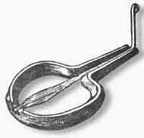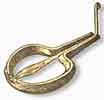GEW GAWS.

Jewes Trump.

GEW GAWS.


WHERE DOES THE NAME Jew's Harp come from: 'The earliest known written citation using the word Jew's harp is in 1595, in England. Prior to that it was called Jew's trump (earliest spelling: jewes trump). Before that it was known as just a trump in Scotland and northern England; the origin of the "jewes" preceder is obscure. However, there is no indication that the origin was connected with Judaism or the Jewish people. It probably came from some other word -- one possibility is the Old English word gewgaw - and was then, many years later, "fixed," resulting in the current form.' - Gordon Frazier, editor of PLUCK (a newsletter for Jew's harpist)
It has also been suggested that the name derives from the French "Jeu-trompe" meaning "toy-trumpet". - Timbs, John (1858). Things Not Generally Known: Popular Errors Explained & Illustrated.
Other names in other countries: Germany - Maultrommel (which means mouth drum), Japan - Koukin, Russia - Vargan, Siberia - Khomus, Philippines - Kumbing and kubing, Italy - Scacciapensieri, Norway - munnharpa or munnharpe, France - guimbarde.
MORE DATED FACTS:
1500 Jew's harps were a common peddler's goods during the 16th century (as well as earlier and later).
1593 Documents show that on May 8, 1593, a Spanish exploratory party was involved in a transaction of 500 Jew's Harps with the natives of NE South America. In a letter to Richard Bentley, Horace Walpole writes, "This very morning I found that part of the purchase of Maryland from the savage proprietors (for we do not massacre, we are such good Christians as only to cheat) was a quantity of vermillion and a parcel of Jew's Harps!"
1650 "Jew's Harps in the New World throughout the colonial period" The iron works at Saugus, Massachusetts (which is near Boston) were producing Jew's Harps as early as about 1650. The June 24, 1660 Parliament lists them among the products requiring an import rate in the colonies. At the turn of the century, 10 gross of Jew's Harps are found in the inventory of three Dutch New York merchants alone. These instruments are also listed in Virginia newspaper advertisements during the middle of the 18th century (the Virginia Gazette is one example).
1677 One land deed of 1677 lists 100 Jew's Harps among the items given as payment for a tract of Indian land. In fact, the use of Jew's Harps as a barter item with the Indians continued till as late as 1815 and 1820.
c1745 JEW'S HARP HOUSE was Lond farmhouse converted to a Resort/tavern with tea gardens, a pond and tropball, tennis, skittles. In 1811 it moved location and still operated as a tavern until at least 1827 This building was destroyed in World War II.
1765 During the period from approximately 1765, Austrian composer and organist and one of Beethoven's music teachers, Johann George Alberchtsberger, wrote a number of concerti for the Jew's Harp.
17th and 18th Century Archaeological research uncovers Jew's Harps from Maine to Florida throughout the 17th and 18th centuries. More than 120 have been recovered from one site in Michigan alone. Conclusive evidence of the use of the Jew's Harp is by no means abundant, except for the fact that practically all of the Jew's Harps which have been archaeological finds have been in dis-repair, which means the tongues were broken and missing. Which says, if they were not playing them and were using them only for barter, then the tongues would not have been broken. Breakage means usage. The majority of the Jew's Harps are found in rubbish heaps and down wells, obviously discarded as useless. Jew's Harps were not only present in the North American colonies, they were being used, and broken, in substantial numbers.
1850 Up until the 1850's, the Jew's Harp attained a remarkable prominence in the musical life of Western Europe.
One great virtuoso Jew's Harpist, was Karl Eulenstein (1802-1890), died at 88 years old. At 8 years old, he started violin lessons (using his father's violin, who died when Karl was 5). He was very musically gifted and practiced daily. When he reached the age for apprenticeship, he went from a bookbinder, to a merchant, and graduated as a baker ... but his first love was always music.
While working for the merchant, he bought his first Jew's Harp.. He fell in love with the Jew's Harp and practiced in his spare time. During this time, he heard the Jew's Harp virtuoso, Franz Koch (1761-1831), in concert. Franz had a powerful affect on him and he decided he also wanted to be a Jew's Harp virtuoso. A few years later, he heard Kunert, another Jew's Harp virtuoso, and was also greatly influenced by him. Soon, he began to compose his own variations to different songs. He tried to set up his own private concerts, but lacking finances, contacts and public playing experience, he was not successful.
He played his first successful concert in Stuttgart, Germany. Soon he became more successful, but always lived near poverty much of the time. He also taught himself to play guitar and was soon becoming well- known throughout Europe for his Jew's Harp mastery. He became recognized as one of the finest players in London ... and played for royalty (such as the Dukes of York, the Duchess of Kent [mother of Queen Victoria], and the King of England). He lost one of his front teeth and with a false tooth, he could not play the Jew's Harp for awhile. He turned to giving guitar lessons for income and was very successful at this for many years. He started playing Jew's Harp again, making a good income. But eventually he lost most of his teeth and had to stop playing Jew's Harp altogether. He married and had three children, living in his native home of Heilbronn until his death. He was truly a great Jew's Harp player and for that reason alone he should never be forgotten. - from http://www.jewsharpguild.org/history.html




